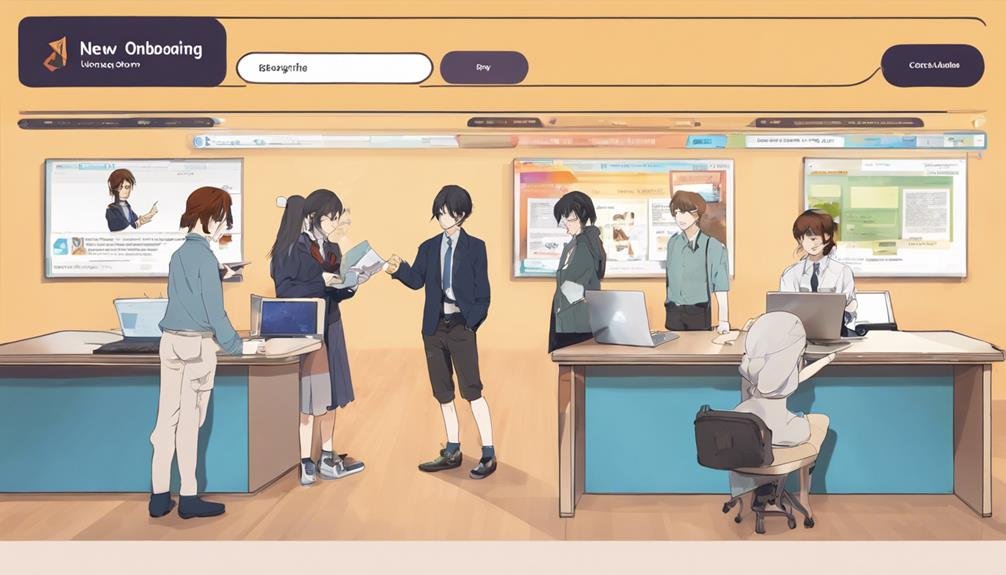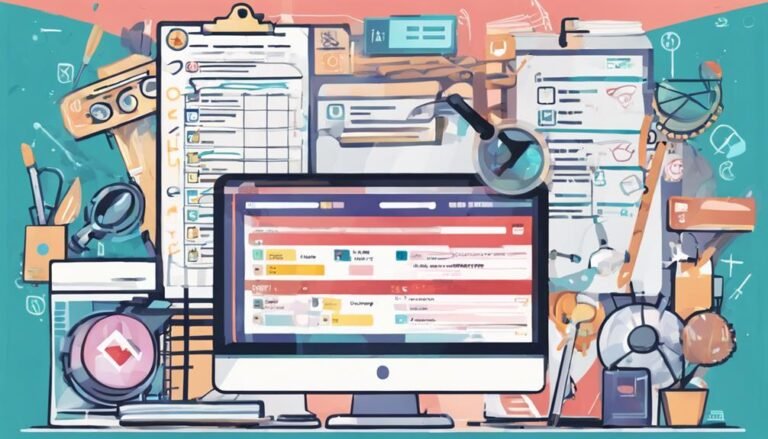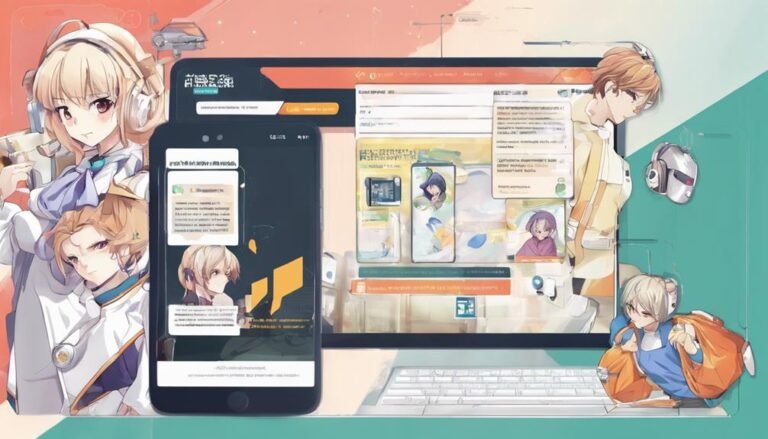How Do I Design Effective Onboarding Experiences for New Online Learners?
To design effective onboarding experiences for new online learners, acknowledge their diverse needs and personalize the process. Set clear expectations by defining goals and providing a roadmap. Create engaging content with visuals and interactive elements to cater to different learning styles. Utilize tools like gamified assessments and interactive simulations. Offer continuous support through peer mentoring and varied resources. Customize learning paths and assessments. Provide one-on-one support for personalized assistance. Collect feedback and monitor progress for continuous improvement. By applying these strategies, you can guarantee a smooth shift and sustained engagement for new online learners.
Key Takeaways
- Tailor onboarding to individual preferences and learning styles.
- Set clear goals and expectations from the outset.
- Create engaging content with visual and interactive elements.
- Provide ongoing support with continuous assistance and tailored resources.
- Offer customized learning paths, interactive assessments, and one-on-one support.
Understanding Learner Needs
To create effective onboarding experiences for online learners, it's essential to first understand their unique needs and preferences. By acknowledging the diverse requirements of each learner, you can tailor your onboarding process to suit individual preferences. Taking a personalized approach is key to ensuring that learners feel engaged and motivated from the start.
Understanding learner needs involves more than just knowing their prior knowledge or technical skills. It requires delving deeper into their motivations, learning styles, and goals. By gathering this information early on, you can design an onboarding experience that resonates with each learner on a personal level.
Encouraging feedback and communication channels can also aid in understanding learner needs better. Providing opportunities for learners to express their preferences and concerns helps in shaping a more tailored onboarding process. Remember, a one-size-fits-all approach rarely works in the online learning environment. Embrace the diversity of your learners and craft onboarding experiences that speak to their individual requirements.
Setting Clear Expectations
Understanding the unique needs of online learners sets the foundation for setting clear expectations in their onboarding experience. Setting goals from the outset is essential. Clearly define what learners should achieve during the onboarding process. By setting specific objectives, you provide a roadmap that helps them understand what's expected. This clarity reduces uncertainty and anxiety, allowing learners to focus on their studies effectively.
Managing expectations is equally important. Be transparent about the course structure, assessment criteria, and time commitments. Clearly communicate deadlines and any prerequisites to avoid confusion. Providing a detailed syllabus or timeline can help learners plan their study schedule accordingly. Setting realistic expectations ensures that learners aren't overwhelmed and can progress steadily through the material.
Creating Engaging Content
Ready to revamp your online course with some engaging content? Let's talk about visual learning strategies and interactive multimedia elements that can captivate your learners.
These key points will help you create a dynamic and interactive learning experience that keeps your audience hooked from start to finish.
Visual Learning Strategies
Engage your online learners effectively by incorporating visually appealing elements in your course content to enhance their learning experience.
Using visuals such as infographics, diagrams, and videos can greatly impact engaging learners and aid in retaining information. Visual aids break down complex concepts, making them easier to understand and remember.
By integrating colorful graphics and illustrations, you can create a more interactive multimedia experience for your online learners, keeping them actively involved and interested. These visual learning strategies not only enhance understanding but also cater to different learning styles, ensuring that your course content is accessible and engaging for a diverse audience.
Interactive Multimedia Elements
To create truly engaging online learning experiences, consider incorporating interactive multimedia elements that captivate and immerse your learners in the course content from the start.
Here are three key elements to enhance your online learning:
- Gamification Benefits: Implement gamified elements such as point systems, badges, and leaderboards to motivate learners and make the learning process more enjoyable.
- Video Tutorials: Utilize video tutorials to explain complex concepts visually and keep learners engaged through dynamic content delivery.
- Interactive Quizzes and Virtual Labs: Integrate interactive quizzes to assess learning progress and virtual labs to provide hands-on experience in a simulated environment, promoting active learning and application of knowledge.
Utilizing Interactive Tools
When designing onboarding experiences for online learners, incorporating interactive tools enhances engagement and facilitates active participation in the learning process. By utilizing gamified assessments, interactive simulations, adaptive quizzes, and virtual labs, you can create a dynamic and immersive learning environment that keeps your learners motivated and excited to progress.
| Interactive Tools | Description |
|---|---|
| Gamified Assessments | Integrate game-like elements into assessments to make learning fun and engaging for learners. |
| Interactive Simulations | Create virtual scenarios that allow learners to apply knowledge in a practical setting, enhancing understanding. |
| Adaptive Quizzes | Tailor quizzes to each learner's progress, providing personalized feedback and promoting self-paced learning. |
| Virtual Labs | Offer hands-on experiences in a digital environment, enabling learners to experiment and learn in a safe space. |
These interactive tools not only make the onboarding process more enjoyable but also help learners retain information better through active participation. Experiment with different tools to find the right mix that suits your audience and learning objectives.
Providing Ongoing Support
As an online learner, you benefit greatly when continuous assistance is readily available and tailored help resources are at your disposal.
Imagine having the support you need at every step of your learning journey, guaranteeing you stay motivated and on track.
Providing ongoing support guarantees that you feel empowered and equipped to succeed in your online learning endeavors.
Continuous Assistance Availability
Ensuring uninterrupted availability of assistance is essential for supporting online learners throughout their learning journey. To provide continuous support, consider the following:
- Peer Mentoring and Live Chat Support:
Encourage peer-to-peer interactions through mentoring programs and real-time chat support for immediate help and collaboration.
- Virtual Office Hours and Interactive Tutorials:
Schedule regular virtual office hours where learners can ask questions and receive guidance. Supplement these with interactive tutorials to cater to different learning styles.
- 24/7 Help Desk or Support Ticket System:
Implement a 24/7 help desk or support ticket system to address technical issues and queries promptly, ensuring learners feel supported at all times.
Tailored Help Resources
For ongoing support tailored to individual learner needs, consider creating a repository of diverse help resources accessible at any time. Customized assistance and support resources can greatly enhance the learning experience. By providing tailored guidance and help materials, you can address specific challenges that learners may encounter during their online journey. These resources should be easily accessible and cover a wide range of topics to cater to different learning styles and preferences. Below is an example of how you can structure your help resources repository:
| Type of Resource | Description |
|---|---|
| Video Tutorials | Visual step-by-step guides |
| Interactive Quizzes | Assess understanding levels |
| FAQ Section | Answers to common queries |
Personalizing the Experience
To enhance the onboarding experience for online learners, personalizing the content to cater to individual preferences and needs is essential. Personalized communication and learner engagement are vital elements in creating a tailored onboarding experience.
Here are three ways to personalize the experience for new online learners:
- Customized Learning Paths: Offer learners the flexibility to choose their learning path based on their prior knowledge, interests, and goals. This approach enhances engagement by providing relevant content that aligns with the learner's needs.
- Interactive Assessments: Implement interactive quizzes and assessments to gauge the learner's knowledge level and learning style. Use this information to tailor the content delivery and provide additional support where needed.
- One-on-One Support: Offer personalized support through mentors, coaches, or online chat services. Direct interaction with a knowledgeable individual can greatly enhance the learner's experience and motivation to engage with the materials.
Collecting Feedback
Consider incorporating feedback collection mechanisms that actively involve learners in the improvement process of the online onboarding experience. By gathering feedback from new online learners, you can gain valuable insights into their experiences and identify areas for enhancement.
Encourage learners to provide feedback on various aspects of the onboarding process, such as the clarity of instructions, the relevance of the content, and the overall user-friendliness of the platform. Utilize surveys, polls, or feedback forms to collect this information efficiently.
Once you have gathered feedback, take the time to conduct a thorough analysis to identify common themes and patterns. Look for recurring suggestions for improvement that can help you enhance the onboarding experience for future learners.
Consider implementing changes based on the feedback received to show learners that their opinions are valued and acted upon. By actively involving learners in the feedback process and implementing improvement suggestions, you can create a more effective and engaging onboarding experience for new online learners.
Monitoring Progress
Are you ready to discover how Progress Tracking Tools, Real-Time Updates, and Data-Driven Decision-Making can revolutionize the way you monitor your learners' progress?
These key points won't only keep you informed about their advancement but also allow you to make informed decisions based on concrete data.
Progress Tracking Tools
Tracking your progress as an online learner can be motivating and insightful, helping you stay on target and adjust your study habits effectively. Utilizing progress tracking tools enhances your learning experience.
Here are three key benefits:
- User Engagement: Interactive progress trackers keep you engaged by visualizing your advancements and remaining tasks.
- Performance Tracking: Detailed analytics show your strengths and weaknesses, enabling targeted improvements in challenging areas.
- Goal Setting: Setting milestones and tracking your progress towards them fosters a sense of accomplishment and motivates continued learning.
Real-Time Updates
Enhance your online learning experience with real-time updates that dynamically monitor your progress. Real-time feedback and interactive quizzes provide immediate responses, allowing you to gauge your understanding instantly.
As you engage with the material, personalized guidance can be offered based on your performance, ensuring you stay on track. These updates create an interactive learning environment where you receive timely insights into your strengths and areas that may need more attention.
Data-Driven Decision-Making
Engage with data-driven insights to make informed decisions about your progress in online learning, empowering you to tailor your approach for best results. By utilizing data analysis and performance metrics, you can effectively monitor your advancement and adjust your learning strategy accordingly.
Here's how data-driven decision-making can enhance your online learning experience:
- Identify Strengths and Weaknesses: Analyze performance metrics to pinpoint areas where you excel and aspects that require improvement.
- Track Progress Over Time: Utilize data analysis tools to monitor your learning journey and observe trends in your development.
- Personalize Learning Strategies: Use insights from performance metrics to customize your study methods and optimize your learning outcomes.
Implementing Gamification Elements
To create an immersive learning environment, consider incorporating gamification elements into your online onboarding experience. By integrating a rewards system, you can motivate new online learners to engage with the content actively. Offering points, badges, or virtual rewards for completing tasks or reaching milestones can boost their excitement and drive to progress through the onboarding process. These rewards serve as incentives for learners to stay engaged and continue developing their skills.
Engagement techniques play a vital role in keeping learners interested and invested in the onboarding experience. Incorporating elements such as quizzes, interactive challenges, or storytelling can make the learning journey more enjoyable and memorable. Additionally, progress tracking features allow learners to monitor their advancement, providing them with a sense of accomplishment as they move through the onboarding program. Visual progress indicators, like progress bars or level completion statuses, can help learners stay motivated and focused on achieving their learning goals.
Measuring Success
Measuring the effectiveness of gamification elements in your onboarding experience can provide valuable insights into learner engagement and progress. Here are three key ways to measure success:
- Measuring Engagement: Utilize analytics tools to track how often learners interact with gamified elements like quizzes, leaderboards, or progress bars. High engagement levels may indicate that learners are actively participating and enjoying the onboarding process.
- Tracking Retention: Monitor dropout rates at different stages of the onboarding journey. If a significant number of learners are disengaging at a particular point, it may signal a need to revise that section for better retention.
- Feedback Surveys: Implement post-onboarding surveys to gather direct feedback from learners. Ask about their experience with the gamification elements, what they found most engaging, and areas for improvement. This qualitative data can complement quantitative metrics to provide a thorough view of the onboarding experience.
Conclusion
In the ever-evolving world of online learning, creating effective onboarding experiences is important for engaging new learners. By understanding their needs, setting clear expectations, and providing ongoing support, you can guarantee a successful learning journey.
Remember to utilize interactive tools, collect feedback, and implement gamification elements to keep learners motivated. By monitoring progress and measuring success, you can continuously improve the onboarding process and create a dynamic, engaging learning environment for all.







